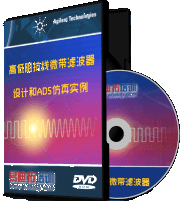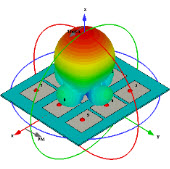弱问关于PA输出级阻抗匹配
我最近也在想这个问题,似乎设计pa时要求晶体管的输出功率最大,而匹配时是负载得到
的功率最大?不明白的是,如果负载得不到输出的全部功率,要那么大的输出功率干什么?
有没有想明白的来说说?
个人认为
一般认为的匹配是小信号匹配,在SMith原图上匹配到50欧姆就OK了
这里有一个前提,就是电路的端口阻抗不随输入输出功率变化,小信号条件。
在功率放大器设计时,输出功率很大,不能采用小信号近似,端口阻抗随输出功率
变化很大,因此无法用SMith原图,S参数等的方法实现匹配
.54
.54
差不多是这样,要让器件大部分情况下不进入饱和截止状态。
PA关注的是输出功率,不是增益,有了这个概念才能理解功率放大器。
未了得到更多输出功率,付出代价边际成本逐渐增加。
匹配
不过是负载线匹配not功率匹配
PA输出都是功率匹配,具体参加Cripps的书
PA输出端在某个值得时候,会输出最大功率或者最大效率。
这个点可以由调试或者Loadpull得到。
你可以认为,这个点是PA输出端很‘高兴’看到的值,你匹配在这个点就OK了。
对PA来说,增益不是最重要的。
重要的是效率和线性(由最大输出功率决定)。
PA的最大输出功率点是可以算出来的,参见cripps的书
简单来讲就是电流和电压的摆幅都可以达到最大,这个时候PA输出的功率最大
loadpull只是使用tuner扫描阻抗,测试在各个阻抗下的输出功率
然后画等功率圆,这个只是结果不是原因
.55
说PA的书大部分是在都是瞎扯
计算最大输出功率点靠的是功率管的模型参数
功率管的模型参数目前最准确的测量方法是用窄脉冲加loadpull
因此loadpull是PA设计最最关键的东西
.254
Where?
瞻仰大牛的Blog。
haha,我说本版的seafire……不是abidi什么的
你搜索一下
我是从他的签名档进去的,具体我也不晓得,叫什么博客大巴来着
http://richard.blogbus.com/
负载线匹配 功率匹配 共轭匹配
这几个概念有些混淆了
清华池老师的书,实际上大部分都是直接译自Cripps的书
但是在这几个概念上的翻译却出现了偏差,不知道为什么
负载线匹配(Chi)=功率匹配(Cripps)
功率匹配(Chi)=共轭匹配(Cripps)
大家仔细对比一下两人的书就知道了
所谓的Cripps Method算出来的最佳阻抗,只是一个实阻
只能用于在没有其他任何可参考信息(比如模型和load-pull数据)时作为参考
实际上功率等高线也是可以通过计算得到的,见Cripps的文章《A Theory for the Prediction of GaAs FET Load-pull Power Contours》
我对比了计算结果和实际load-pull测试的等高线,差别还是不小
当然以在片load-pull测试数据为准
RealPrince说的没错,如果想通过计算得到准确的最佳阻抗
晶体管的模型必须非常准确(DC,小信号和大信号都要拟合很好)
建模中,有些至关重要的参数需要用到脉冲测试
可是,非常精确的器件大信号模型很少(用于高频高功率PA,低频低功率另论)
我觉得最可靠的办法还是在片的load-pull测试
和池保勇老师交流过这个问题,他们做CMOS PA只是用Cripps Method计算一个实阻
作为最佳负载阻抗,他说结果可接受就可以,当然最好还是load-pull测试了
另外,关于PA的书,我觉得Cripps的几本书还是非常值得一读的
1. 《RF Power Amplifiers for Wireless Communications》,1st Edition
2. 《RF Power Amplifiers for Wireless Communications》,2nd Edition,增加不少内容
3. 《Advanced Techniques in RF Power Amplifier Design》
Cripps的书比较艰涩难懂,但开卷之后颇有收获,UCLA的Yuanxun Ethan Wang极力推荐的,大家可以看看。
下面是一位前辈写的关于如何获得最佳阻抗的三种方法,与大家分享:
(找不到作者和出处了,在笔记中翻出来的,回头再找找)
The following methods to determine the optimum load impedance were considered:
(1). The use of the so-called Cripps method.
This method uses a simplified model of the transistor, which can be obtained from small-signal S-parameter measurements at the bias point of interest and knowledge of the DC IV curves. With the help of this information it is possible to construct load-pull contours and the optimum load impedance can be determined.
The Cripps method was not used because of the following limitations:
A. The DC IV curves are not always similar to the AC IV curves;
B. Other essential information for the high-power amplifier design is missing e.g. the input impedance of the transistor under large-signal conditions when it is loaded with the optimum load impedance;
C. Modeling of the external part of a transistor with only the drain to source capacitance is too simplistic. Certainly for large transistors, as it is the case for the discussed high-power amplifiers, the influence of the drain-source resistance and the parasitic inductances on the external optimum impedance can no longer be neglected.
However, if no large-signal transistor model or load-pull measurement set-up is available it can give a reasonable estimation of the optimum load impedance.
(2). The use of load-pull simulations performed with the help of the large-signal transistor model and the contour test bench available in the Agilent Series IV simulation software. Comparison with load-pull measurements shows, that the transistor model will give a good estimation of the location of the optimum load impedance in the case of maximum output power. This becomes more difficult if an optimum load impedance for maximum power added efficiency is searched. This is due to the overestimation of the drain current by the transistor model.
(3). The use of load-pull measurements is still the preferred method to determine the optimum load impedance. When this type of measurements is performed, information becomes available regarding the load impedance of the interstage-matching network.
关于load-pull测试,可能很多兄弟都没有实际见过。我们实验室有一套DC-20GHz的load-pull探针测试设备,大家如果想了解什么相关信息,可以问我,欢迎交流。
赞
pa是真么东东?
准不准是要看工作频率和输出功率,
如果做GSM PA算出来的还是很准的
如果做几十GHz的PA,微带模型本身就不是很准
load-pull只是知道怎么测试
如果要知道原因的话还是需要深刻理解load line
你的讨论很赞~
.55
.55
load pull的matlab code看得我就头大。。唉
.137
哦,我计算的是6.2GHz的PA MMIC,
不准可能就是因为你说的频率和功率的问题
频率高的时候很多寄生参数将使等高线的位置和形状发生变化
rainybbs说的对,load-pull测试出来的等高线是结果而不是原因
其实为什么会出现功率等高线,原因说到底也很简单
从负载线理论出发就可以推出来
呵呵,另外就是几十GHz的PA MMIC
我们现在想做W波段的PA,发现最简单
因为没有任何可靠的测试数据(只有DC,没有S,没有load-pull)
模型也完全不准确了
那只好按照理想状况+电磁场仿真来做了
反正谁也不能预测做出来是个什么东西
呵呵
微所开始做W波段。。。去哪里测试?
.122
相关文章:
- 阻抗匹配有没有好的软件来做! (05-08)
- 在ADS中如何实现带通滤波器与前置放大器的阻抗匹配?(05-08)
- 请教一个阻抗匹配的问题(05-08)
- 负载阻抗不定,如何阻抗匹配(05-08)
- 请教:关于阻抗匹配,我总有一点想不通.(05-08)
- 关于混频器的输出阻抗匹配问题(05-08)











